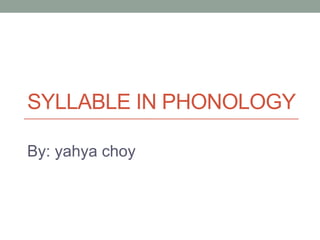
Syllable in phonology
- 1. SYLLABLE IN PHONOLOGY By: yahya choy
- 2. • Words can be cut up into units called syllables. • Syllable is a unit of spoken language consisting of a single uninterrupted sound. • Humans seem to need syllables as a way of segmenting the stream of speech and giving it a rhythm of strong and weak beats. • Syllables exist only to make speech easier for the brain to process. • A word contains at least one syllable.
- 3. Determine how many syllables are in the following words: • Emily • Trevor • Suzy • Restroom • Recess • Book • Environment
- 4. Syllables and their parts • The parts are onset and rhyme; within the rhyme we find the nucleus and coda. • Not all syllables have all parts; the smallest possible syllable contains a nucleus only. • A syllable may or may not have an onset and a coda.
- 5. Onset (O) • Onset: the beginning sounds of the syllable; the ones preceding the nucleus. • These are always consonants in English. The nucleus is a vowel in most cases, although the consonants [ r ], [ l ], [ m ], [ n ], and the velar nasal (the 'ng' sound) can also be the nucleus of a syllable.
- 6. Rhyme (R) • Rhyme (or rime): the rest of the syllable, after the onset (the underlined portions of the words above). The rhyme can also be divided up: Rhyme = nucleus + coda
- 7. Nucleus (N) • is the core or essential part of a syllable. A nucleus must be present in order for a syllable to be present. • In English and most other languages, most syllable nuclei are vowels. • The English liquids [ r l ] and the nasals [ m n ] can be the nuclei of syllables under certain conditions. [ r ] can be a nucleus as easily as a vowel, in any position: the words 'bird', have [ r ] as the nucleus; in other words, there is no vowel in the pronunciation of these syllables, even though they have one in the spelling. [brd]
- 8. • [ l ] and the nasals [ m n ] become syllable nuclei when they follow an alveolar consonant in the last syllable of a word. This happens in the relaxed or casual rather than very formal articulation of the word. Compare casual vs. formal pronunciations of 'button', 'bottle', 'bottom'.
- 9. • Coda (C) • Coda is the ending sound of the syllable, the ones preceding the nucleus. • These are always consonants in English. • Onsets are strongly preferred over codas • Consonants in codas are weakened: think of what happens to r in many English dialects (car [kaa] versus red). Coda consonants are much longer. They affect stress patterns.
- 10. • Linguists often use tree diagrams to illustrate syllable structure. 'Flop', for example, would look like this (the word appears in IPA symbols, not English spelling). 's' = 'syllable'; 'O' = 'onset'; 'R' = 'rhyme'; 'N' = 'nucleus'; 'C' = 'coda'. • The syllable node at the top of the tree branches into Onset and Rhyme; the Onset node branches because it contains two consonants, [ f ] and [ l ]. The Rhyme node branches because this syllable has both a nucleus and a coda. • σ / O R / / | | NC | | | | [f l a p]
- 11. Steps to determine the diagram: a. Determine the nucleus (N) b. Add Rhyme ( R ) on the ordinate of the nucleus c. Determine the onset (O) and the coda (C).
- 12. If a syllable has the coda, it is called as closed syllable Example : cap, sit, man If a syllable doesn’t have the coda it is called as open syllable. Example : he, she, me
- 13. Draw, the syllable structure of the following words: apron basic began begin depend even hotel
- 14. Syllables and Clusters • A syllable must contain a vowel or a vowel-like sound. • The most common type of syllable in a language has a consonant as well. • When describing syllables: C = consonant V = vowel
- 15. Coda, onset and nucleus syllable onset rhyme (optional) Nucleus coda (not optional) (optional) one or more consonants vowel one or more consonants
- 16. syllables open syllables closed syllables Syllables which end syllables which in a vowel and end in a coda no coda ‘consonants’
- 17. • Consonant clusters: both the onset and the coda can consist of more that one consonant e.g. green (CCVC) street (CCCVC) post (CVCC)
- 18. Syllabic consonants • Sometimes when a vowel is elided a consonant can become a syllabic nucleus. • Only a consonant in the coda can become a syllabic nucleus. • Only the following actual consonants can become syllabic nuclei: • /l m n/
- 19. Syllables and stress • Some syllables are more prominent than others. • These are termed ‘stressed’ syllables. • Stress is related to the location of a syllable in a word.
- 20. Exercise Which is the stressed syllable in the following words? income stupid induce Phantom
